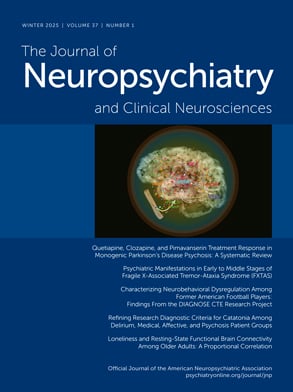To the Editor: Behavioral-variant frontotemporal dementia (bvFTD) is characterized by marked alterations in behavior, personality, and social conduct, related to metabolic alterations of the medial prefrontal cortex (mPFC).
1 In early bvFTD, patients may show preserved performance in traditional executive tasks,
2 while presenting early impaired performance on the Iowa Gambling Task, (IGT), which assesses decision-making under ambiguous conditions and taps mPFC functions.
3 Although the progressive prefrontal neurodegeneration has been seen, no studies assessed the progression of decision-making impairment in bvFTD. We hypothesized that decision-making may worsen along the course of bvFTD, and, to test this hypothesis, we longitudinally assessed two bvFTD patients, matched with 10 healthy controls (HC).
“MM” was a 49-year-old woman, working as doorperson. She presented a pattern of behavioral alterations (apathy, decline in personal hygiene, bizarre behaviors) and cognitive impairment involving executive functions and visuospatial functions. SPECT showed hypoperfusion in the right fronto-parieto-temporal cortex and in the left superior gyrus; 18FFDG PET showed a bilateral extended reduction of the glucose metabolism in the frontal, prefrontal, temporal, posterior parietal, and occipito-parietal areas.
“MS” was a 56-year-old engineer. He presented a pattern of behavioral alterations (marked apathy, difficulties at work, aggressiveness) and cognitive impairment involving executive functions and episodic memory. SPECT showed moderate hypoperfusion in the left temporal and parietal cortices; 18FDG-PET showed an extended area of hypometabolism in the left parieto-temporal cortex, extended to the insula and the hippocampus and in the left infero-mesial frontal gyrus.
Patients MM and MS received a clinical diagnosis of bvFTD. Their executive functioning was followed longitudinally, including decision-making ability, with the IGT, whose quantitative parameter consists of the net number of advantageous choices computed for the whole set of 100 cards.
Patients attained these IGT scores: MM: −10 (baseline), −18 (5 months after baseline); MS: 0 (baseline), −2 (11 months after baseline), −14 (20 months after baseline). The mean total IGT score of HCs was 6.08 (SD: 6.82). Adopting a Bayesian inferential method,
4 results showed that, compared with HCs, all IGT performances of MM were significantly lower (p<0.01), whereas only the third IGT performance of MS was significantly lower (p<0.05).
IGT performances of these patients globally suggest that decision-making may worsen along the course of bvFTD, confirming our hypothesis. Worsening of decision-making occurred with a general worsening of executive functioning, suggesting that these two phenomena could be somehow related. However, IGT accounts for variance in decision-making performance not currently attributable to classic measures of executive functioning;
5 therefore, the longitudinal worsening of performances in a task that principally taps mPFC functions (IGT) and in tasks that principally tap dorsolateral PFC functions (other executive tasks) is probably more due to a progressive neurodegeneration affecting both these prefrontal regions than to the reciprocal influence between these different prefrontal functions.
This study suggests that the IGT is a useful neuropsychological tool for detecting earliest signs of cognitive impairment and then its worsening in bvFTD patients.

